A Complete Guide to Mutso, Georgia’s Fairytale Fortress
12 min readEverything you need to know before you visit Mutso (Mitsu), a reconstructed fortress-village in Khevsureti.
An exceptional example of a fortified village where the tower-dwellings are interlinked to form one single line of defence, Mutso was once regarded the most inviolable stronghold on Georgia’s north-eastern frontier.
Climbing up and into the knot of medieval stone towers perched high above the river valley delivers awe-inspiring views of the Caucasus, and allows you to get up close and personal with one of Georgia’s most incredible landmarks.
Easy to reach from the nearby village of Shatili, visiting Mutso is a highlight of any Khevsureti itinerary. This guide covers everything you need to know to plan your trip.
Please note: This post contains affiliate links, meaning I may earn a commission if you make a purchase by clicking a link (at no extra cost to you). Learn more.
What & where is Mutso?
Mutso is a medieval fortified village in Georgia’s historic Khevsureti region (part of present-day Mtskheta-Mtianeti). Located close to the Chechen border on a mountainside high above the Andakistskali River, 12 kilometres or approximately 45 minutes by road from Shatili, it was long known for being the most robust fortification in the area – the outpost least likely to fall to enemy invaders.
Mitsu as it used to be known – a name that some families are currently petitioning to bring back – is a tiny cluster of around 30 reconstructed buildings, a mix of fortified dwellings (tower houses), military towers, and various burial crypts and shrines. Arranged vertically into an upper and lower village, with one structure stacked on top of the other, everything is made from local stone and blends seamlessly into the surrounding mountains.
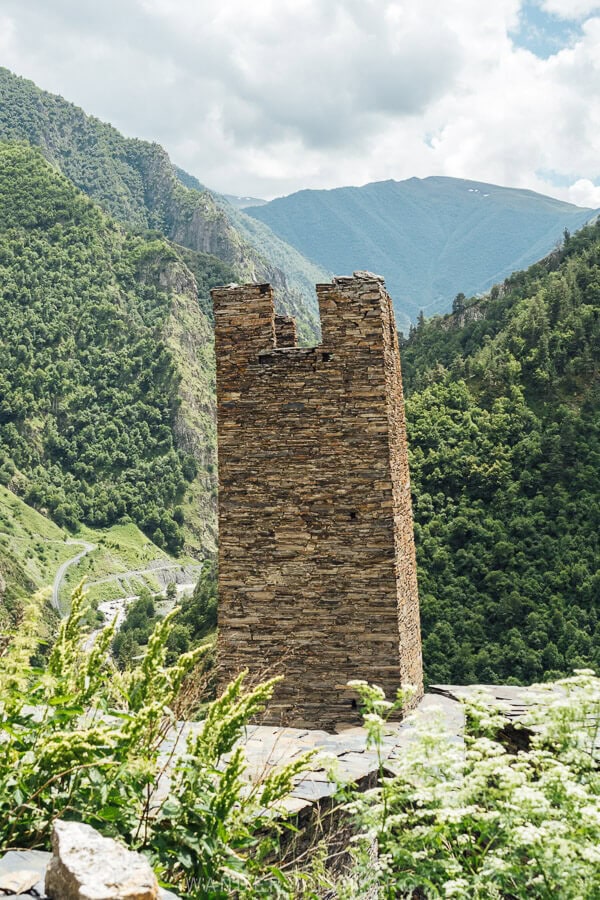
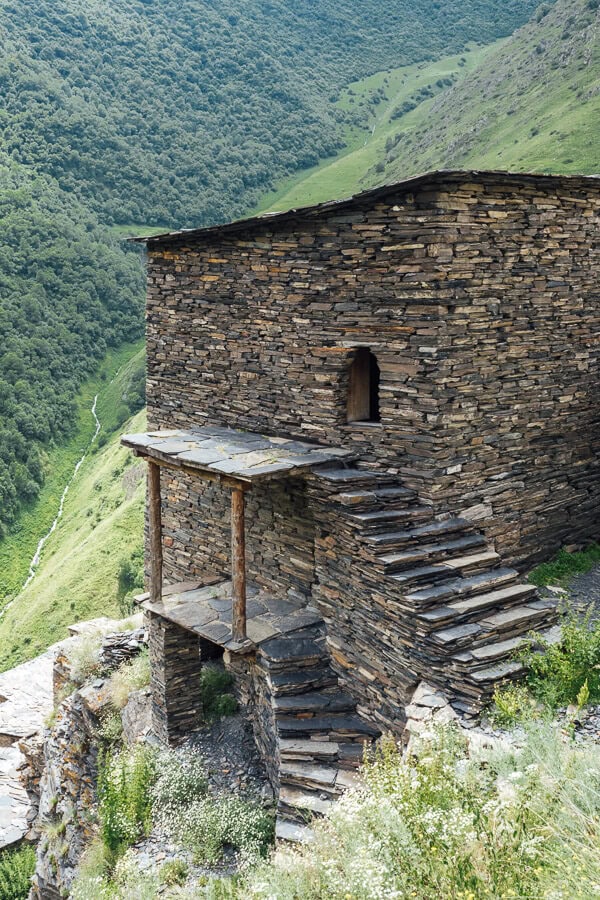
There is no definitive date that I can find for Mutso’s founding. Allegedly the village was inhabited from the 10th century onwards by a group of people renowned for their fierce fighting and hunting prowess. Legend has it that Mutso’s residents were guardians of a fabulous bounty and a revered icon, the Broliskalo Icon of Archangel, which are still hidden somewhere in the mountains.
Mutso has a fairytale-like quality, and it is tempting to fall into romantic stories of warriors and princesses when discussing it. Like all of Khevsureti, it has a crucial place in Georgian folklore. It’s important to also note the difficulties families have faced, from enemy invasion to forced resettlement in the lowlands during the Soviet period, leading to the eventual abandonment of the village.
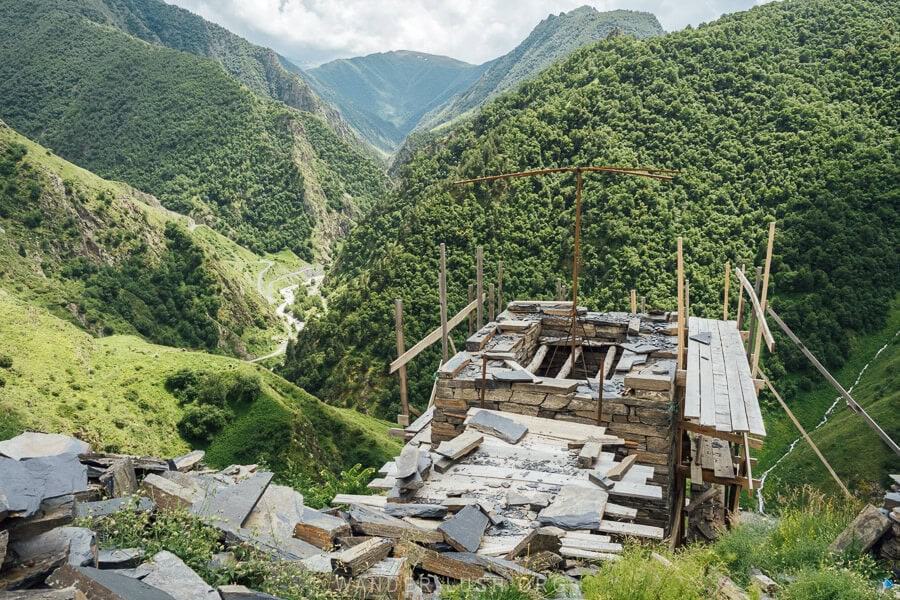
Today there is only one family living in Mutso for part of the year. It is counted among the most critically endangered of Georgia’s historic sites, and because of that, it has been the focus of much research and investment. In 2014, a project commenced to reconstruct some of the towers. In 2019, these efforts earned Mutso an EU Prize for Cultural Heritage.
How to get to Mutso
The only way to reach Mutso is via the road from Shatili and Korsha through the Datvisjvari Pass. Public transport (marshrutka vans) only go as far as Shatili, so unless you have your own car, you will need to find a private driver to take you the rest of the way.
It takes around 5 hours total to reach Mutso from Tbilisi when travelling by car.
For more details about the marshrutka van service and group tours to Shatili and Mutso, refer to this guide: How to get to Shatili from Tbilisi (published soon).
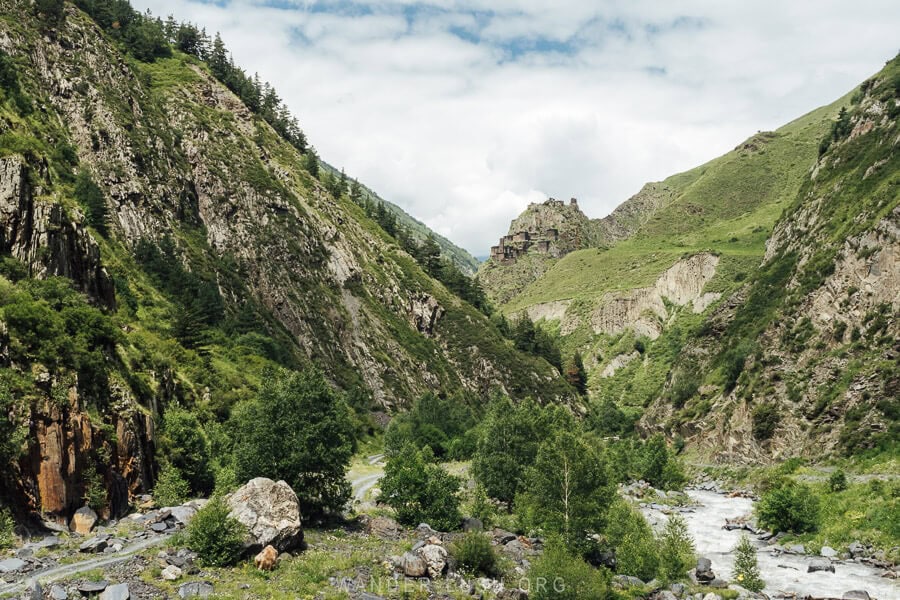
Road conditions in Khevsureti are varied: around Zhinvali (as you leave Tbilisi), there is a beautiful new sealed road that runs almost all the way to Korsha. On either side of the pass, the gravel road is more challenging, with narrow sections and tight bends.
This area is prone to flooding and landslips, so it is not recommended to travel in the days following heavy rain. There are areas where the road is falling into the river, and overall the level of road maintenance is far from good.
Though much easier than the road to Tusheti, the pass is still a challenging drive that should only be attempted by experienced drivers in the right weather conditions. In the past few years there have been several tragic accidents in this area – do not underestimate the importance of road safety.
For Mutso and the entire section of Khevsureti beyond the pass, I recommend travelling with an experienced driver. If you need a recommendation, please get in touch via email and I will be happy to refer you to the driver we used for our trip.
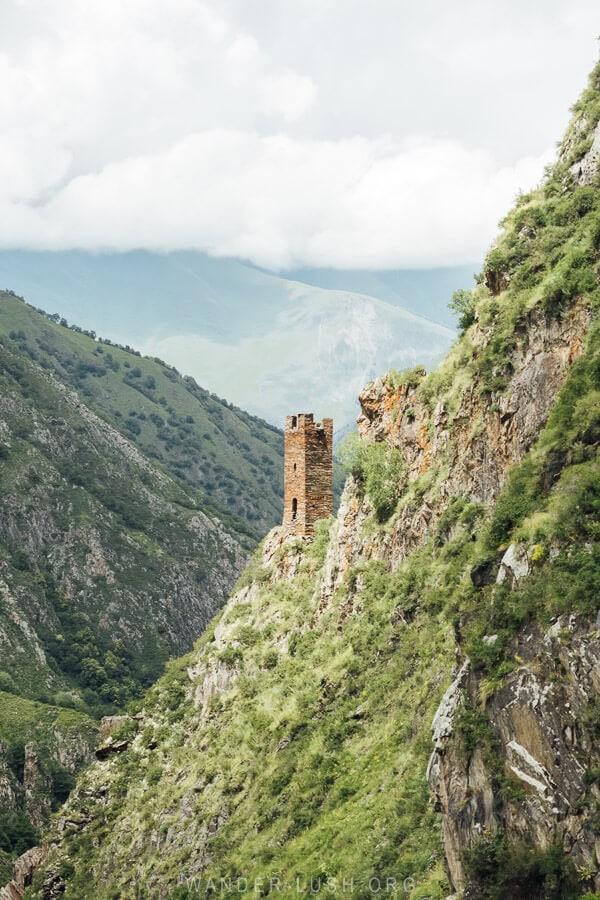
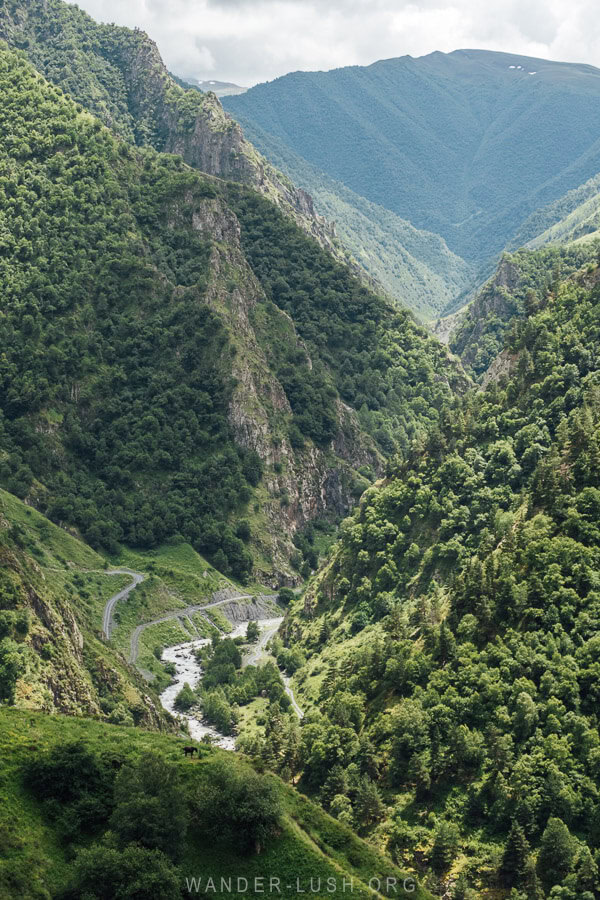
If you do decide to self-drive to Mutso, you will need a 4WD with high undercarriage clearance. We had a Toyota RAV4. Many rental companies prohibit you from taking their cars on this road, so check the fine print before you book.
Offroad cars from Martyna z Gruzji can be driven up to Shatili – mention wanderlush when you book to receive 10% off.
It is equally essential to check road conditions before you set off – use the GeoRoad Facebook Page/hotline to learn of any closures, and if possible ask a local in Khevsureti (e.g. your guesthouse host) if there is anything you should be aware of.
Best time to go
The best (and only) time to visit Mutso and Khevsureti more broadly is during the summer months. The road is not maintained during winter, and it is not possible to drive up between November and May approximately. Most families in Khevsureti leave to spend their winter in the lowlands as villages beyond the pass are cut-off.
I recommend visiting Mutso between late June and mid-September. Our trip took place in the last week of June, and it was still a bit wet and stormy. July/August is the safest period in terms of good weather.
Khevsureti is a popular day trip from Tbilisi for Georgians. It is noticeably busier on weekends – so if it’s important for you to experience the area with fewer people around, try to visit on a weekday.
Mutso’s fortified towers
There is only one thing to do in Mutso, and that is to hike up into the fortress-village. Unlike in Shatili where the towers are on road-level, Mutso is perched high above the river – 1,880 metres above sea level. To get up, you must follow the steep walking track. It’s about one kilometre in total, taking an hour or so each way (with plenty of stops).
A highlight of visiting Mutso is getting up close and personal with the towers – though it must be said that they are even more impressive when viewed from afar. On the road in from Khonischala/Ardoti, you get a wonderful view of Mutso sandwiched between the mountains. This gives you a better sense for the village’s remoteness and strategic position.
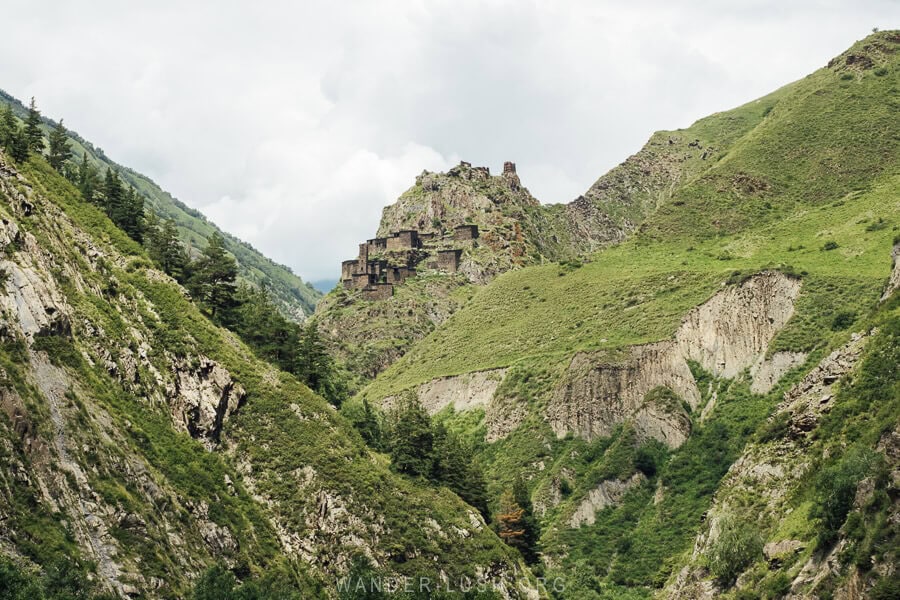
I immediately noticed how different the towers in Khevsureti are to those found in Svaneti, for example. These towers are short and stout with a sturdy square base, constructed from local stone, sometimes dry-build and other times held together with lime mortar. They vary in size from two to four storeys, with the different internal levels separated by wooden rafters that hold up the floor/ceiling.
Like in Svaneti, Mutso’s towers were either built purely for defensive purposes, or they were created as fortified dwellings. The first two levels of a residential tower were reserved for livestock, with living spaces arranged above. All of a family’s possessions – from their clothing and carpets to cooking utensils and most importantly, weapons – were kept on the upper levels.
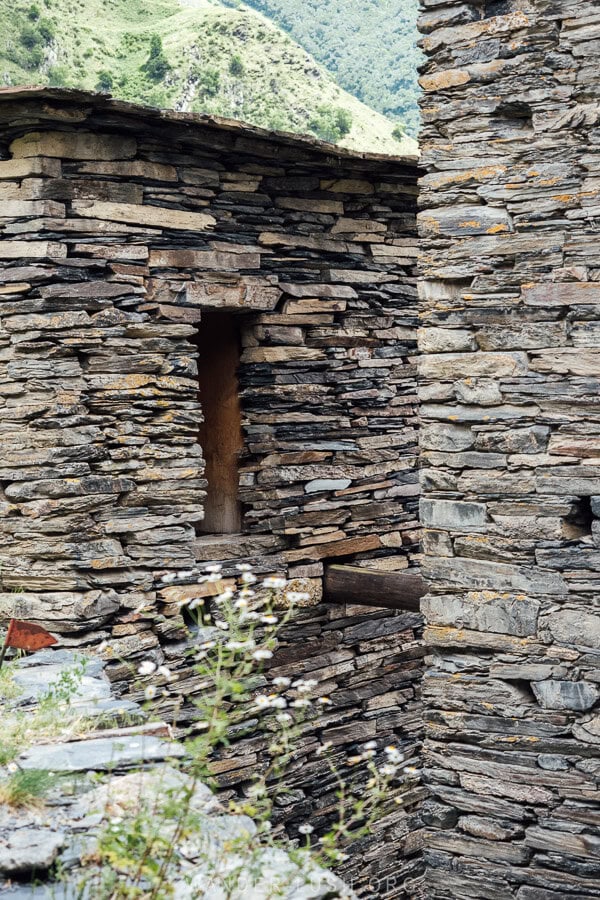
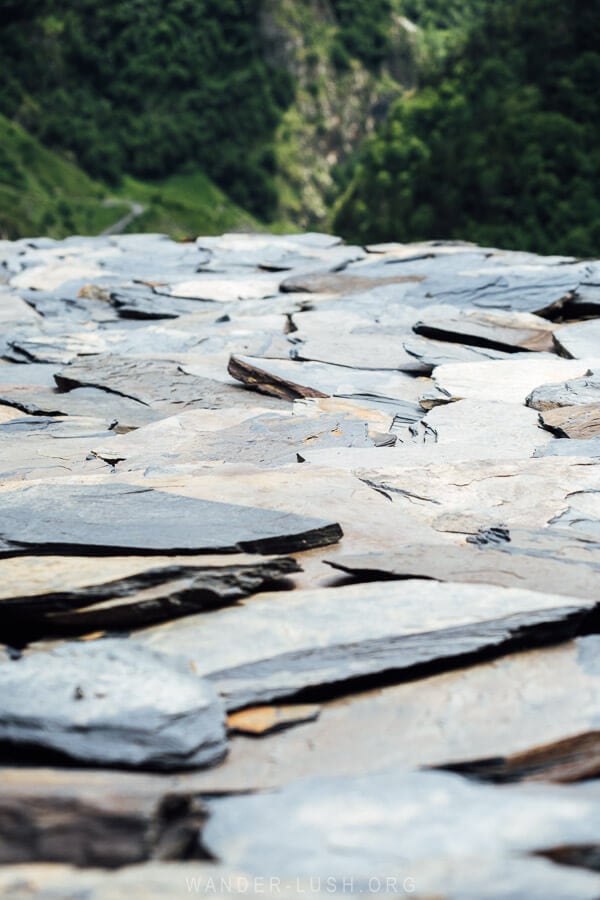
The restored Mutso towers are mostly unadorned. Some have been refitted with heavy wooden doors, while others remain open and exposed. There are very few log ramps or surviving examples of the elevated wooden bridges built to interconnect houses – these flourishes can be found in Shatili, though.
Clan towers in Khevsureti are known for being decorated with stone pictogram inscriptions. Some depict astrological symbols, while others have motifs representing animals or something related to the tower’s architect. We didn’t see any pictograms in Mutso, but we did find a few in Shatili.
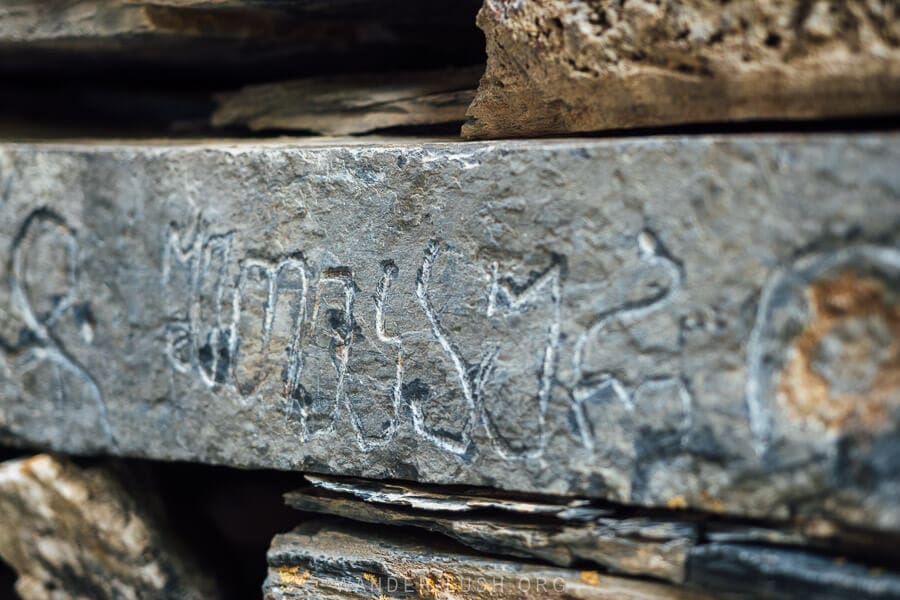
One thing we did see in Mutso is an inscription of the name Shetekauri on one of the external walls – but it looked quite new. People with the surname Shetekauri hail from Khevsureti, and the family is connected with Mutso’s founding legend.
The Mutso hike
A little note to remind you that Mutso (and Khevsureti more generally) is quite a physically demanding destination. It is closer to Tusheti than it is to Svaneti or Kazbegi in terms of amenities and creature comforts. For a full comparison between Georgia’s different mountain regions, see this guide.
The walk to the towers from the road is short, but it is almost entirely uphill over uneven ground, including loose rocks. It therefore requires a reasonable level of fitness and steadiness on one’s feet. For advice on how to prepare, see my Mutso tips below.
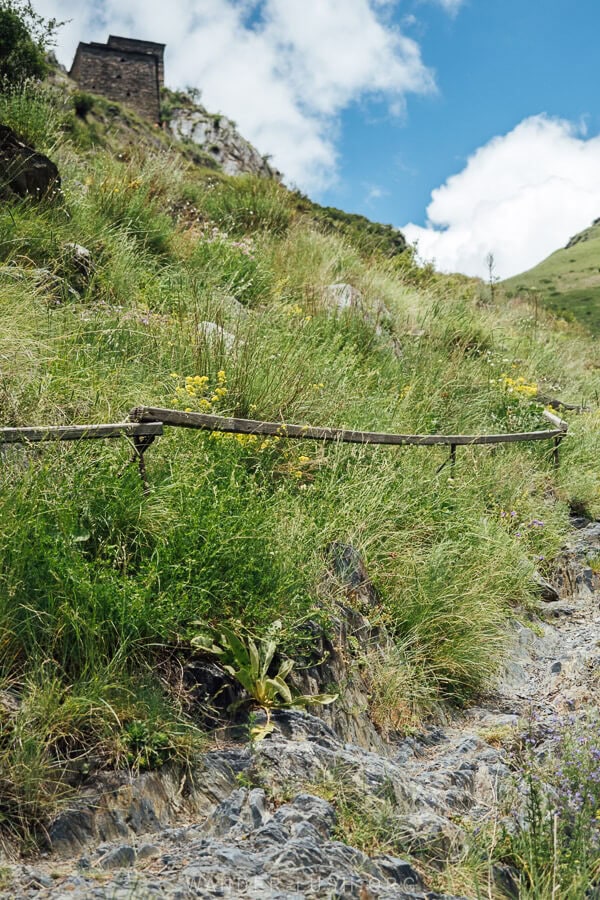
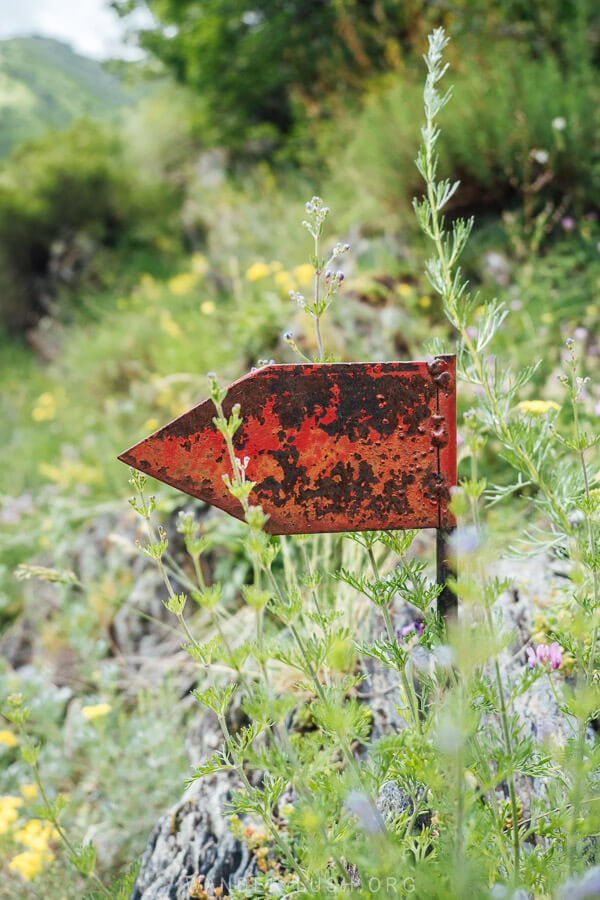
There are no barricades or safety rails. There are a few sections of the vertiginous walking path that have makeshift wooden handrails, but other than that, there is nothing much to prevent you from sliding off the path. If you are travelling with children, you will need to keep a close eye on them at all times. Consider only going as far as the plateau and skipping the upper part of the village where the trails are comparatively steep.
Below, I have broken the walk up into stages, and describe some of the points of interest to see on your way up to the towers.
Mutso crypts
Starting from the road, you will first hike up to a small plateau. The trail takes you past a house – use the stone steps to the right of the building to continue your path skywards.
During this first part of the walk, the trail zigzags up the mountainside. You will notice little side paths that dart off towards the precipice. Some of these lead to small crypts.
Constructed from the same dry stone and blending seamlessly into the rocky landscape, these burial vaults still contain human remains, including bones and skulls.
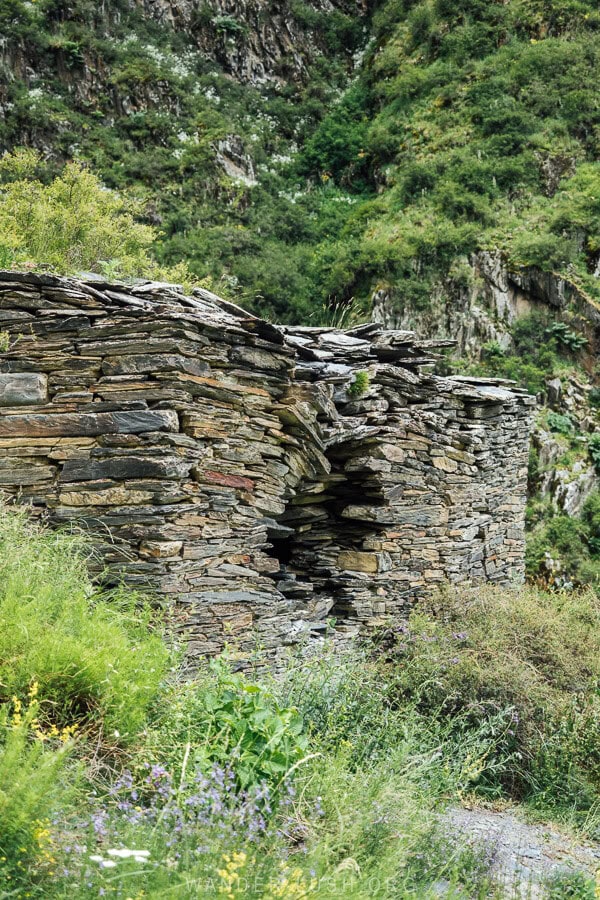
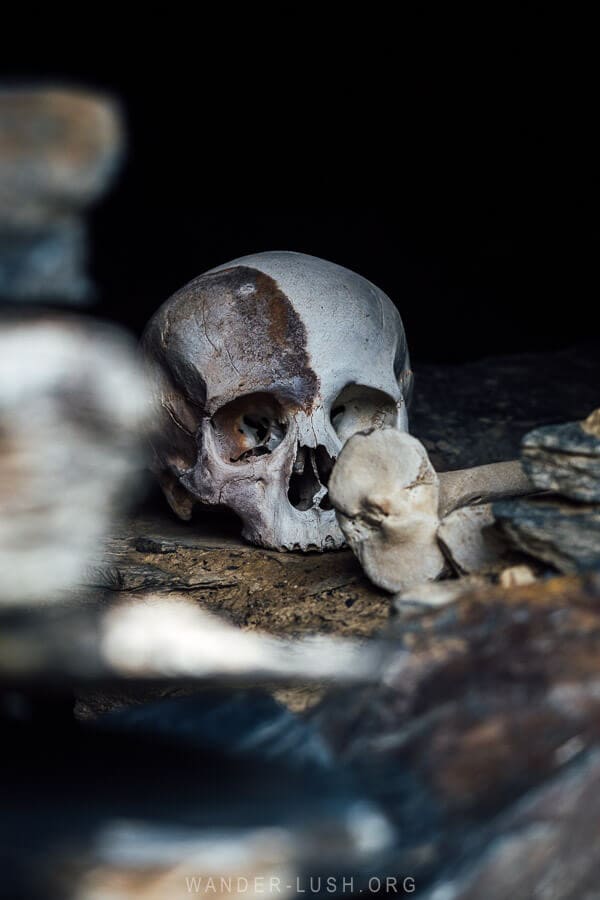
The Anatori Crypts near Shatili are better known, but the ones at Mutso are even more interesting because they are not barred off. It does feel quite dark and voyeuristic to look at (and photograph) the tombs.
Keep your eyes peeled from more crypts on the opposite side of the valley. They are very well disguised and almost impossible to pick out.
Torghva’s Tower
As you crest the first rise to enter the plateau, a stone watchtower appears directly in your line of sight. The moment it comes into view is one of the most special parts of the walk and a sight I will never forget.
Known as Torghva’s Tower, it sits on a ledge overlooking the river, north of the main village complex. It is associated with Torghva Dzagani, a hero of Khevsurian folklore who hailed from Mutso.
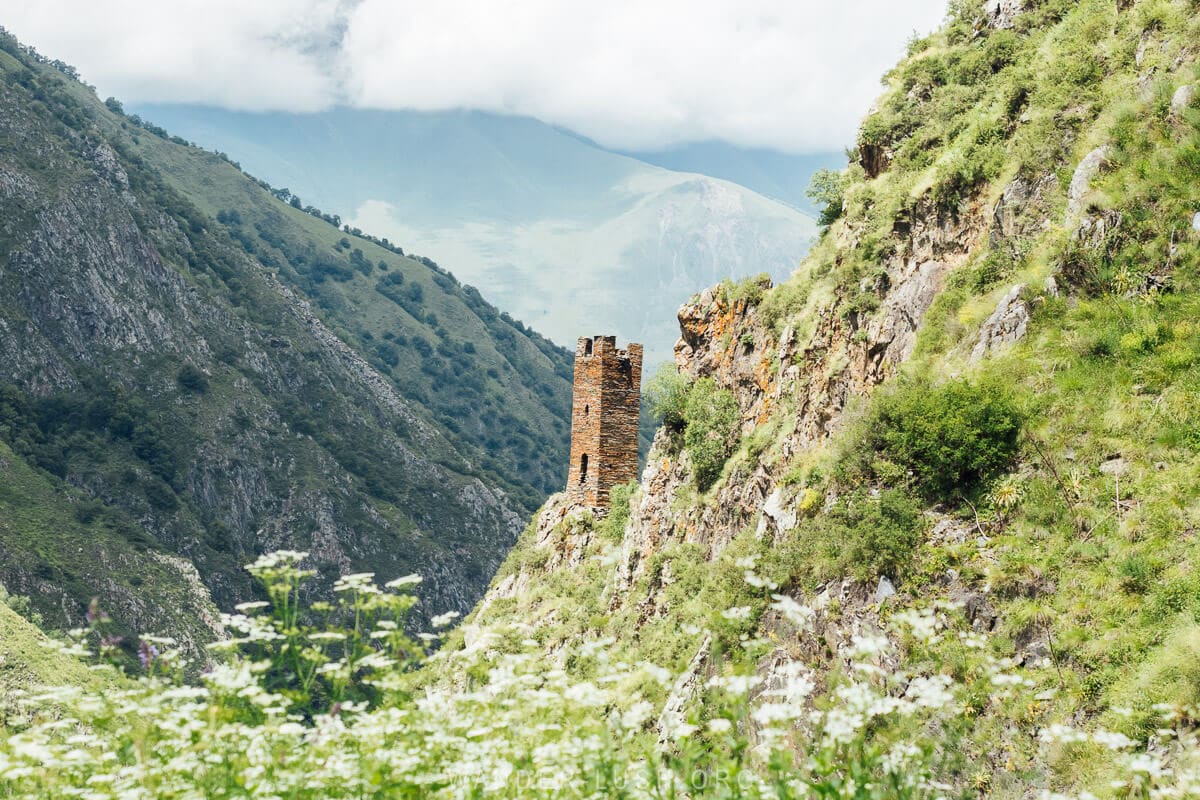
Until recently, the tower was a pile of rubble. It was pieced back together, stone by stone, as part of the restoration. I did not see an obvious path out to the tower – and because the location is quite perilous, you would need to take great care if you were to try and walk out.
More examples of towers in Khevsureti include the Tsiskarauli Family Tower in Akhieli, which was restored in 2023 under a National Trust of Georgia project, and the Lebaiskari Tower seen on the drive to Shatili just after the Datvisjvari Pass.
The plateau
When you reach the plateau, the ground flattens out and there are places where you can sit down in the grass to catch your breath. The area is dotted with more stone tombs and shrines. I witnessed people clamouring over the roofs to take photos – I would caution against this as you never know how structurally sound they are (not to mention that these are heritage monuments).
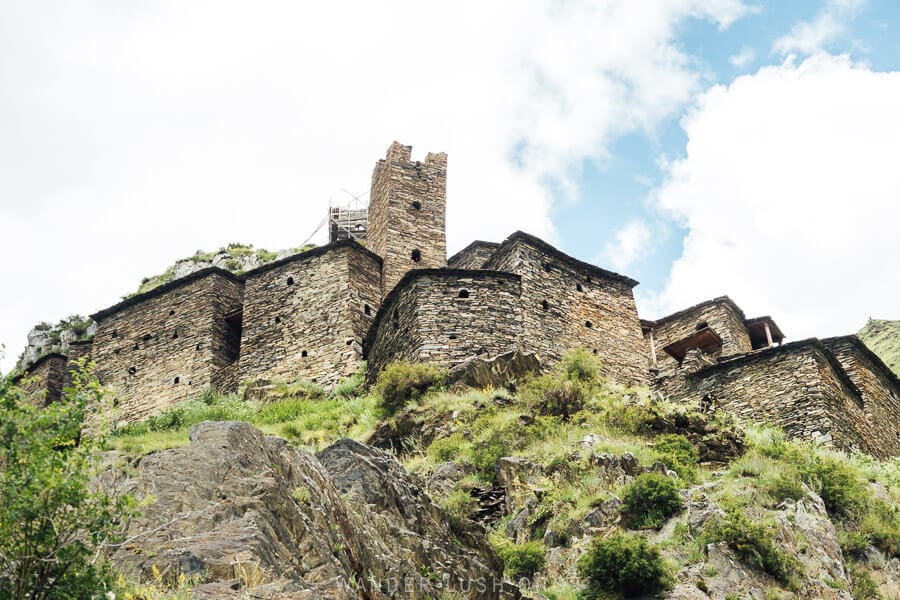
Spend a good chunk of time here, walking out to various points for different views of the mountains and river. Looking north, you can see the Torghva Tower (perhaps framed by wildflowers if you visit in early summer) teetering over the valley.
At this point you are standing directly beneath the village. Look up to see the stone towers silhouetted against the sky.
Mutso fortress-village
The next part of the walk is a bit gnarly as the path steepens and you end up walking over bare rocks. At certain points there are via ferrata-style ropes and hand holds. But it is nothing too scary – I am not a huge fan of heights, but I managed it just fine.
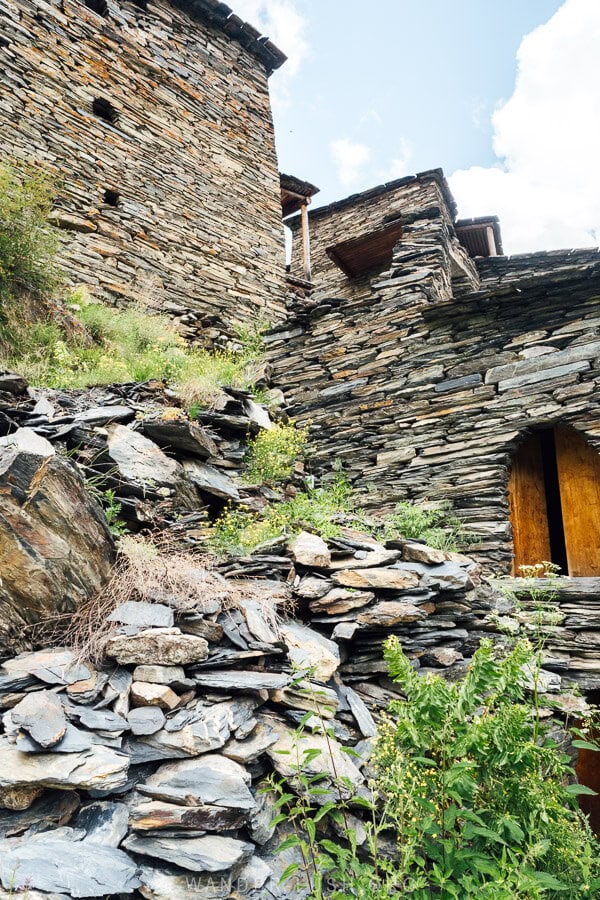
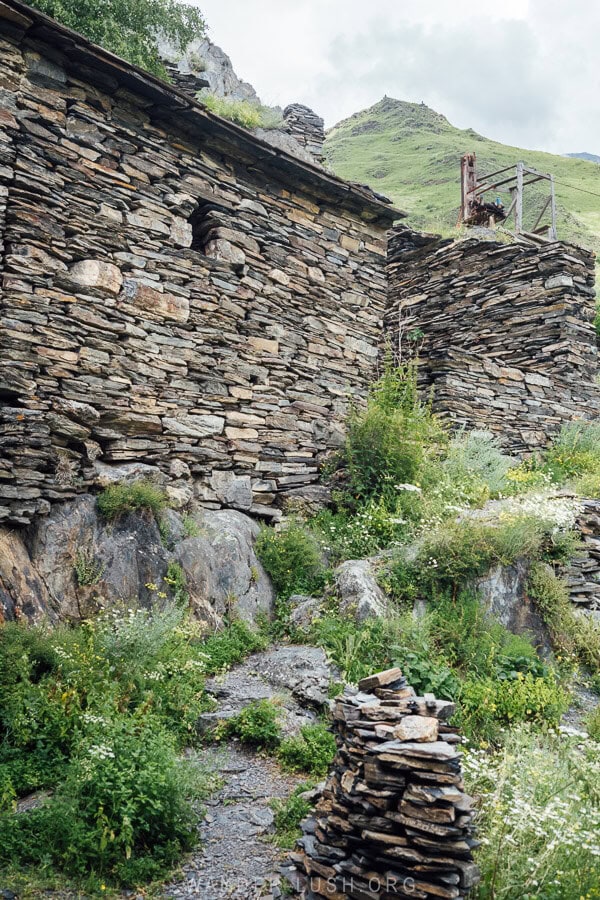
As you near the top, you will see a stone structure with an almost Arabesque-shaped portal off to your right. This is a small Orthodox church, mounted with a cross and an icon. We walked over for a closer look only to see a ‘no entry’ sign lying nearby in the grass.
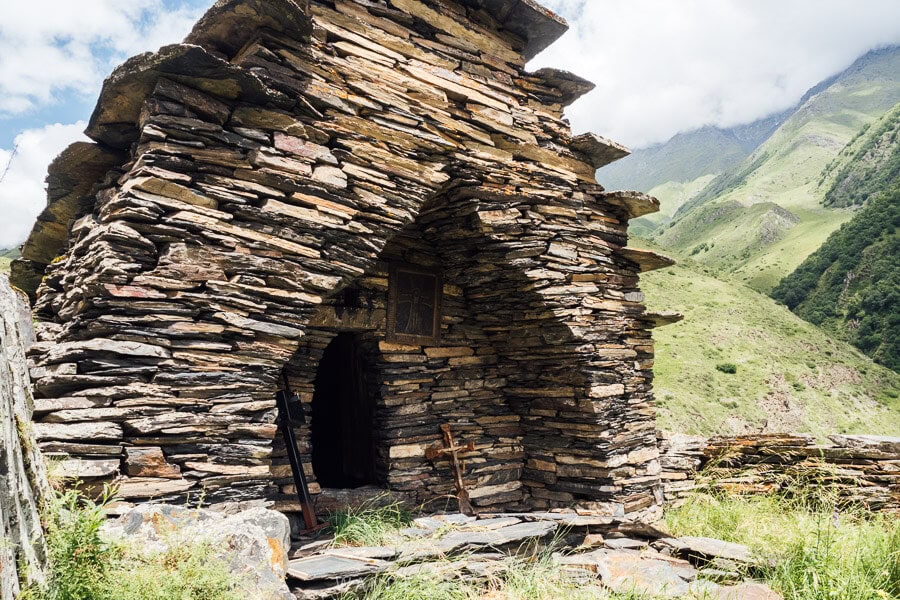
Inside the village, a maze of narrow pathways runs between the towers. It is easy to lose your bearings here, but the area is so small that you needn’t worry. The restored towers are empty for now (I don’t know what is in store for the towers – perhaps some of them will be reoccupied in the future?), and most have open doorways. Pop inside to view the rebuilt interiors.
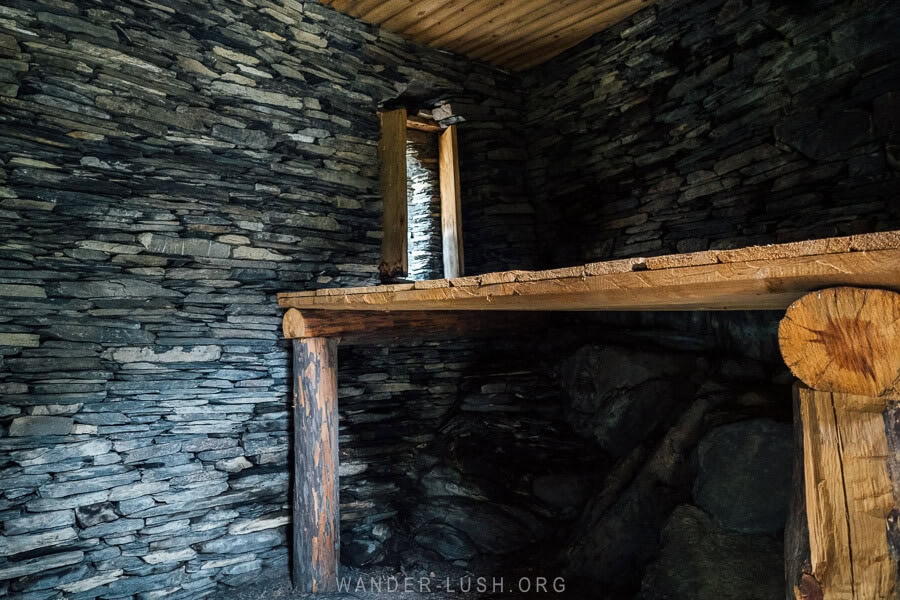
The lookout point
As you climb further up through the terraced village, you will see equipment (pulleys and the like) used for the ongoing restoration works. At first we thought the tracks could have been the makings of Georgia’s most extreme rollercoaster!
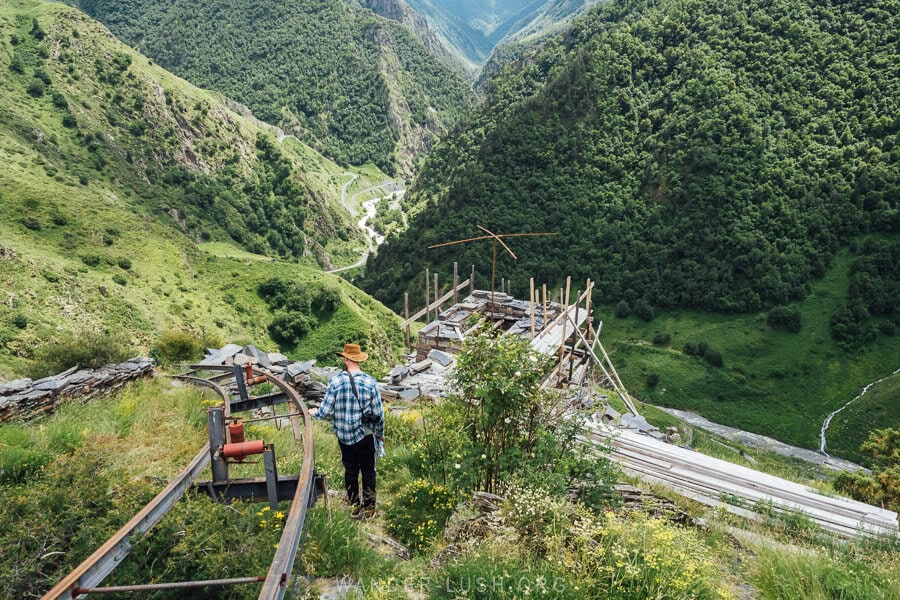
Eventually you reach the highest point of the complex, another much smaller plateau with more panoramic views.
At the highest point of Mutso there is a shine out on a narrow isthmus that only men are permitted to enter. Out of respect, it is important that women avoid approaching the area.
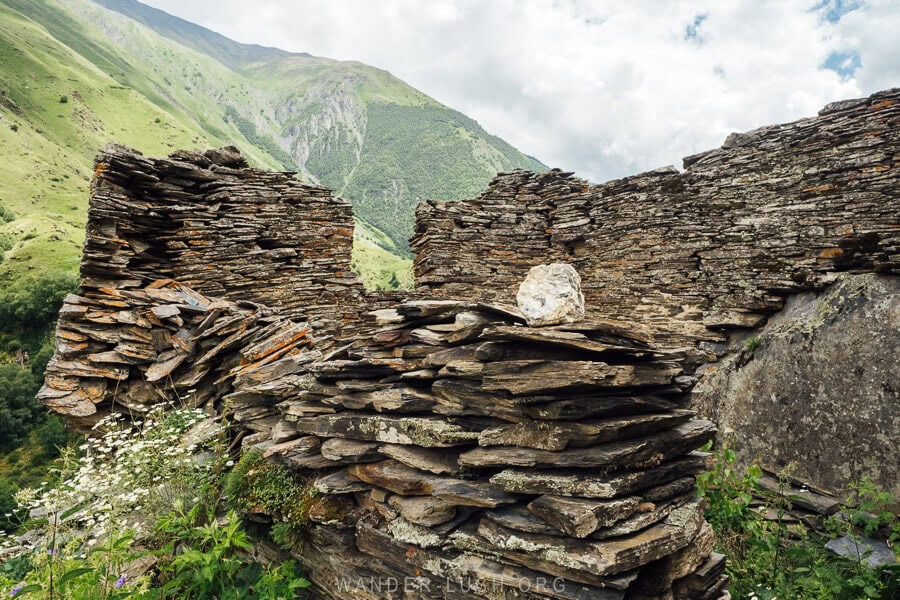
To get back down to the road, return the same way you came, taking care not to lose your footing on the steep downhill paths.
Mutso travel tips
- Give yourself at least 2 hours to visit Mutso. The walk up to the highest point of the complex took us just under an hour (including lots of photo stops and detours to the tombs), while it took us another 45 minutes or so to walk back down.
- There is a small parking area in front of Muco Restaurant where you can park whilst you complete the hike.
- No permits or special permissions are required to visit Mutso, and you will not encounter any security checkpoints or border control stations.
- There is no obvious water source in Mutso, so remember to bring drinking water with you. The restaurant sells cold drinks and snacks but prices are quite high.
- There is no phone signal in this part of Khevsureti. Muco (Mutso) Restaurant has free WIFI for customers.
- The restaurant only accepts cash. There is no ATM in Mutso or Shatili.
- The restaurant has a unique bathroom – I do recommend paying a visit!
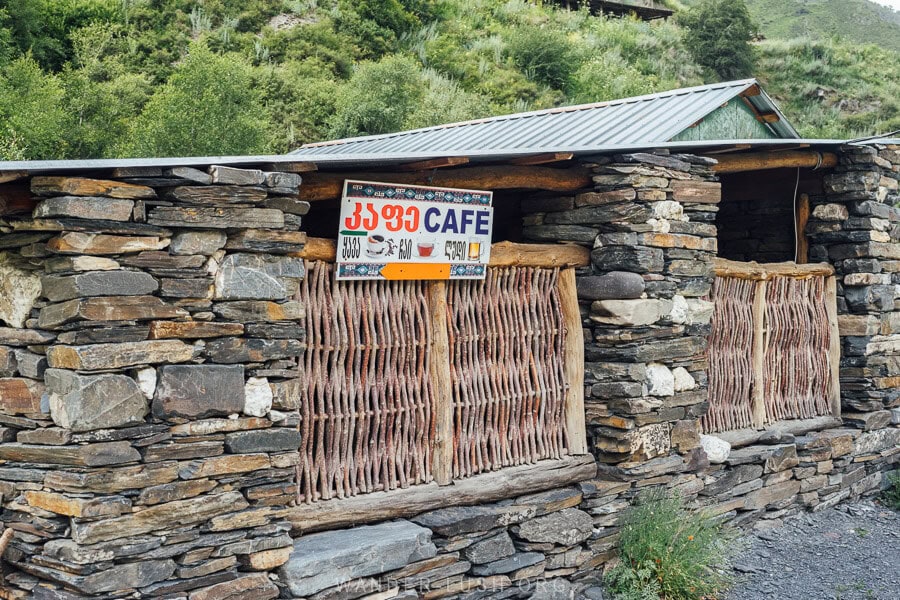
- For the hike, I recommend you wear hiking boots or sturdy sneakers at a minimum. The trails is overgrown in places, so long pants are a good idea. If you have trekking poles, those will also come in handy.
- Try to not venture too far from the marked trail. The terrain is very steep and there are drop offs everywhere.
- As long as you stick to the path, it is not possible to get lost. You do not need a guide for this hike.
Where to stay near Mutso
There are no guesthouses or hotels in Mutso. The most convenient places to stay are in Shatili (north-west of Mutso via the main road) or Khonischala/Ardoti (small villages deeper in the mountains). Shatili is easy to access, but getting to the more remote villages of Khonischala and Ardoti involves crossing a river.
Ethnic Hostel (Shatili): Managed by Irma and her husband, this lovely guesthouse is set in a traditional tower overlooking Shatili. Rooms are very comfortable, the breakfast is great, and the view from the rooftop terrace couldn’t be better.
Guest House Grilo (Khonischala): We were lucky enough to be the very first guests at this new guesthouse in Khonischala village. Its location close to the Atsunta Pass is very convenient for hikers, and it’s a nice place to spend a quiet night if you want to go deeper into Khevsureti.



